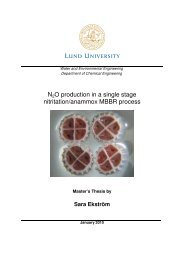Alexander Szabo and Oscar Engle - Svenskt Vatten
Alexander Szabo and Oscar Engle - Svenskt Vatten
Alexander Szabo and Oscar Engle - Svenskt Vatten
Create successful ePaper yourself
Turn your PDF publications into a flip-book with our unique Google optimized e-Paper software.
value of 4:1 in length/width ratio. Within each case it was reported that increasing the<br />
length/width ratio <strong>and</strong> introducing baffles slightly increases the water velocity <strong>and</strong> DO in the<br />
effluent water (Abbas et al., 2006). The conclusion drawn from these data simulations is that a<br />
pond should have a length/width ratio of 4:1 <strong>and</strong> at least two baffles.<br />
5.2 Facultative <strong>and</strong> maturation ponds in Sri Pulai, Johor Bahru,<br />
Malaysia.<br />
An analysis of the performance of a waste water stabilization pond in Sri Pulai, Johor Bahru was<br />
done in 2002. The treatment system uses a primary facultative pond followed by a maturation<br />
pond (Ujang et al., 2002). This is the same pond arrangement as used at UTM. The system in Sri<br />
Pulai serves a population equivalent (P.E.) of 10 327 from a residential area of approximately 0.7<br />
km 2 . The ponds together cover an area of 17.725 m 2 , with pond volumes of 16.275 m 3 for the<br />
facultative pond <strong>and</strong> 10 115 m 3 for the maturation pond. The volume of the facultative pond<br />
should result in a retention time of about 30 days. Around 40 % of the incoming water is assumed<br />
to origin from infiltrating ground water (Ujang et al., 2002).<br />
Table 5.2: Average waste water characteristics at Sri Pulai WSP. The influent results is based on 24<br />
samples, the results from the effluent facultative pond <strong>and</strong> the effluent maturation pond is based on<br />
14 respectively 7 samples. (re-drawn from Ujang et al., 2002)<br />
COD (mg O 2 / SS (g/l) NH 4 -N (mg/l) NO 3 -N (mg/l)<br />
l)<br />
Influent<br />
Effluent facultative pond<br />
446<br />
139<br />
146<br />
48<br />
23.1<br />
19.7<br />
1.5<br />
1.6<br />
Effluent maturation pond<br />
114<br />
41 16.8<br />
1.2<br />
Removal in entire pond<br />
system<br />
74% 72% 27%<br />
20%<br />
Removal in facultative pond<br />
Removal in maturation pond<br />
69%<br />
18%<br />
67%<br />
15%<br />
15%<br />
15%<br />
- 7%<br />
25%<br />
Compared with the effluent st<strong>and</strong>ard for Malaysia, the treatment process was not sufficient, since<br />
the total COD concentration of the effluent was on average 114 mg O 2 /l (see Table 5.2). The<br />
Malaysian effluent st<strong>and</strong>ard B is set to 100 mg COD/l (Ujang et al., 2002).<br />
The authors´ conclusion of the unexpected low treatment efficiency (the pond should be able to<br />
meet st<strong>and</strong>ard B) could partly be caused by hydraulic short-circuiting. The low treatment<br />
efficiency could also be caused by the specific growth rates of biological degrading bacteria not<br />
being so temperature dependent as expected. The authors recommended aeration <strong>and</strong> installation<br />
of baffles to improve the treatment.<br />
<br />
25















